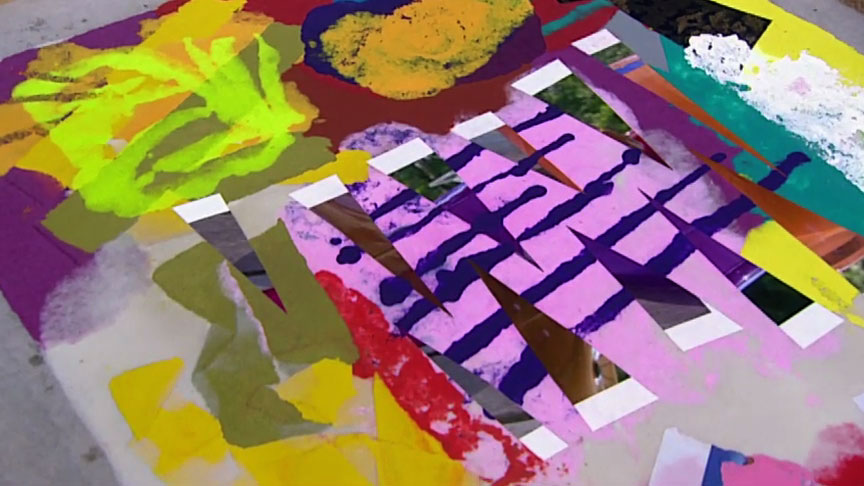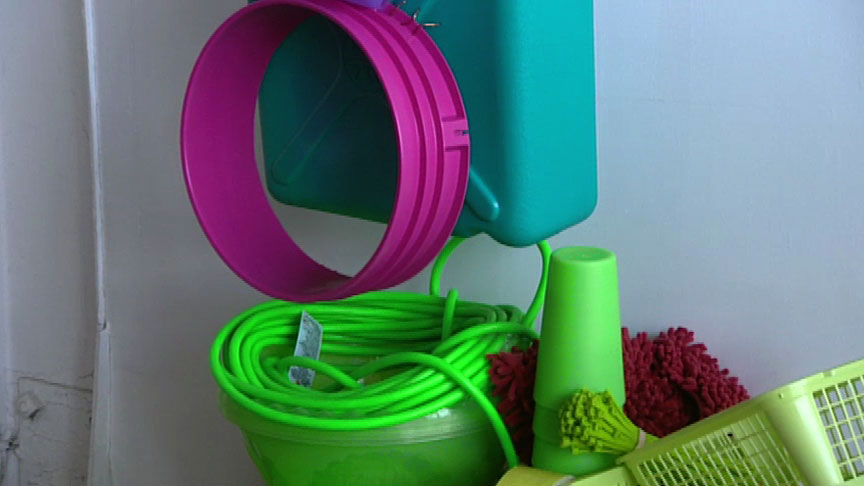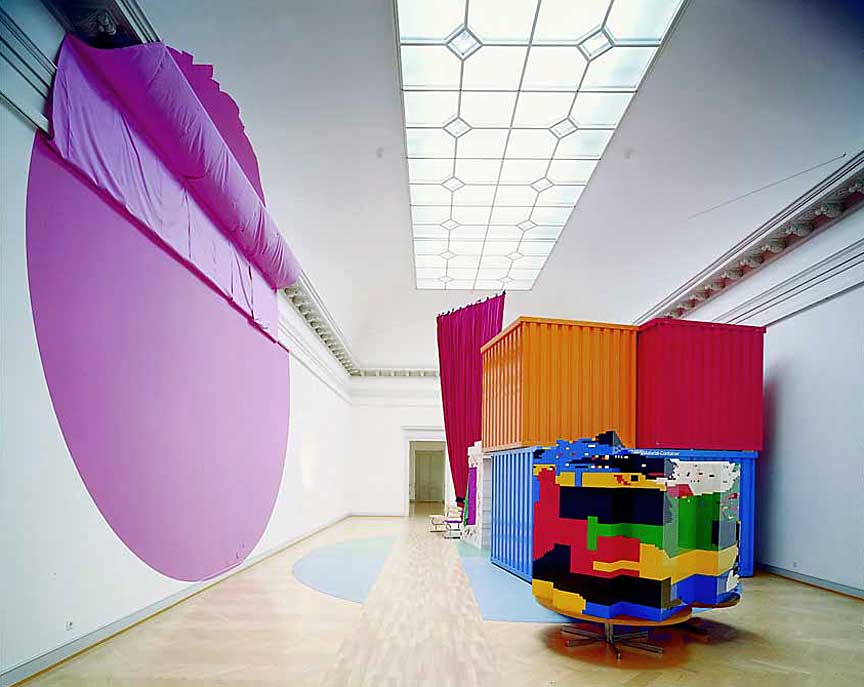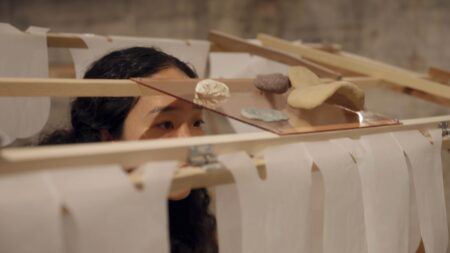Interview
Pleasure, Politics, and Beauty

Jessica Stockholder at work with Master Papermaker Paul Wong at Dieu Donné, New York, 2004. Production still from the Art in the Twenty-First Century Season 3 episode, Play. © Art21, Inc. 2005.
In this interview, Jessica Stockholder talks about her ideas of beauty and abstraction in relation to formalist aesthetics.
ART21: Do you think abstract forms have meaning?
STOCKHOLDER: People sometimes think that formalism means the work is meaningless, empty. “He (or she) is a formalist”—that is thrown at different artists. Well, form means everything. We don’t make anything or think anything outside of form. We have conventions of form for every activity: brushing your teeth, sitting at the table, reading the paper. And form is also beautiful, it’s intensely beautiful, but it’s hard to articulate why.
I think it’s a little bit like watching people play the piano. Obviously, people’s fingers learn how to play; they don’t sit and think about each note. Working with color, form, shape, and things physical—in the way that I’m working—I know what I’m doing on some level, both physically and conceptually. There’s a kind of thinking process that goes on that I can’t tell you about. I can’t think about each and every one of those little tiny decisions and put words to it, and still work. There’s a lot going on that you have to just go with and trust that it’s significant.
One of the things I wanted to talk about is that my work’s really about pleasure. It’s not always pleasurable to make. Sometimes it’s excruciating. Sometimes I come into the studio, and it’s horrible to be here, and I have to leave after an hour. But sometimes it’s really a pleasure. And the work, in the end, is at least in part about pleasure.
You know, I’ve been thinking about why that matters, and I think pleasure matters a great deal. Pleasure is very political, and pleasure is part of what controls people. Advertising is directed at our pleasure, and homophobia is about where people find pleasure. I think, growing up—how and what pleasures us is carefully controlled. Socially, people have a lot of opinions about it. Babies, pacifiers, and bottles—hugely fraught subject, because it has something to do with people’s pleasure.
Carol Gilligan’s book In A Different Voice, and more recently The Birth of Pleasure, talks about the development of girls and boys. The work she’s done documents boys at about the age of five having two voices—one that really accounts for their experience, and the other that’s more socially appropriate. And girls do that at about age eleven. That’s about pleasure. In order to understand how people are socially controlled, for better or worse, I think you have to pay attention to what gives you pleasure and how pleasure matters. This work, for me, certainly functions that way. It’s about making sense of discomfort, dissonance, and struggle in relationship to pleasure.
ART21: Do you think of your work as political?
STOCKHOLDER: I don’t come to this work through books. I don’t make this work in response to other people’s theory. And I don’t think about what the piece means and then make it. I’m involved in this process of making things because it matters to me a great deal. And I try to unravel it, and figure out why it matters to me, and then why it might matter to other people. I mean, the work is personal, and I think everybody’s work is personal. But work isn’t interesting to other people because of my personal life. It’s interesting because people struggle with similar issues.
So, how you make sense of living, how you make sense of emotional life, how you make sense of struggle and pleasure—those things have social and political implications. But I’m not working, here, trying to change the world. It’s not political in that sense, and I’m not illustrating political propaganda or an agenda. I discover what the politics might be in the work through the process of being engaged in it.

Jessica Stockholder in her studio, New Haven, CT, 2004. Production still from the Art in the Twenty-First Century Season 3 episode, Play. © Art21, Inc. 2005
ART21: Do you think about beauty?
STOCKHOLDER: I think about beauty and taste. I mean, I think the work’s beautiful. Then I step back: what does that mean, to think the work’s beautiful? I think beauty has to do with biology, just like bees like flowers. People like certain things. Some people think my work is not beautiful. History, culture, fashion—it changes what people think all the time. And taste is tied to class, hierarchy, and social structure. Those words get mixed up: tasteful and beautiful. Though beautiful is supposed to be more transcendent where taste would be insignificant perhaps, depending on who you are.
ART21: How do you define beauty?
STOCKHOLDER: I don’t worry about defining it; I experience it. And it shifts. For me, it has something to do with struggle. Things that are beautiful are beautiful because they are difficult. It has something to do with stretching and expanding what I know—opening up a little more space in my own mind.
ART21: Light fixtures seem important in the work. Why?
STOCKHOLDER: Lights plug into the wall and call attention to the electrical wires that are in the wall. It’s static to look at these light bulbs. They don’t do anything. It’s a static, still image that the lights present. But it is an event because electricity moves, and the electricity is active in the wall. So, conceptually I like it—that the stillness of the work is disrupted. I’m very much in love with the work being still, and picture making is about still things. I’m interested in still pictures, but the electricity isn’t actually still. So, I like that disruption. And also, I like plugging these things into the wall. They are sited. They’re attached to the wall in a very particular way.
ART21: How do you think about the materials you use?
STOCKHOLDER: I think, you know, that I treat materials lightly. I like that there’s expectation embedded in material. By disrupting what’s expected, you reveal significance and structures of thinking that aren’t obvious otherwise. There’s also just a pleasure in moving things around, treating them in ways that they’re not normally treated—discovering things about material, form, and structure that you have to stumble on, by moving things.

Jessica Stockholder. Vortex in the Play of Theatre with Real Passion: In Memory of Kay Stockholder, 2000. Installation at Kunstmuseum St. Gallen. Duplo, theatre curtain, work site containers, bench, theatre light, linoleum, tables, fur, newspaper, fabric and paint, dimensions site-specific. Collection Kunstmuseum St. Gallen, St. Gallen, Switzerland. Courtesy of the artist and Mitchell-Innes & Nash, New York.
ART21: What role does the wall play in your pieces?
STOCKHOLDER: I like the wall. The wall being part of the work matters to me a great deal—not taking for granted how these things are in space and in the world. A painting is a conventional form, a rectangular thing that hangs on the wall. It’s a convention that you can then forget about, and then just look at what’s inside the painting. And a sculptural pedestal—that’s another form, where you put the thing on the pedestal, and then sort of forget how it’s in the world. You just look at this thing on the pedestal. It seemed to me that those conventions of how things are in the world—how they are in relationship to us moving around, and how they are in relationship to buildings—is part of their content. So, with each one of these works, I kind of invent a slightly different way for it to be attached to the architecture.
ART21: All of the details are carefully orchestrated.
STOCKHOLDER: Oh, yes, formally that’s all very controlled. Things are composed, and I’m interested in thinking about composition. Composition, like formalism, has been debunked somehow—like, being involved in composition means that you’ve descended into the world of meaninglessness. But that can’t be; composition is charged. Everything is composed. So, I’m interested in thinking about that and spending time with it: why is one composition riveting while another lacks tension and is boring? And yes, things can be composed and facile, or they can be composed so that you never think about the composition, just the whole experience.
ART21: Talk about your use of the ephemeral.
STOCKHOLDER: Everything’s ephemeral, and the installation pieces have a short life. The show’s usually up for three or four weeks—that’s quite a long time if you think of it as an event, but short if you think of it as your standard, forever art. Because I’m not worried about keeping them forever, there are all kinds of things I can do with these pieces that are really exciting: I can play with materials without any thought for whether they’ll yellow next year or how to move them around. All the practical considerations for keeping things are not there, and that’s a real weight lifted off. Even the pieces I make in the studio—I’m not attached to them as objects. My pleasure and excitement in making them is not about making an object. It’s about the events that the object engenders or enables.
This interview was originally published on PBS.org in September 2005 and was republished on Art21.org in November 2011.



